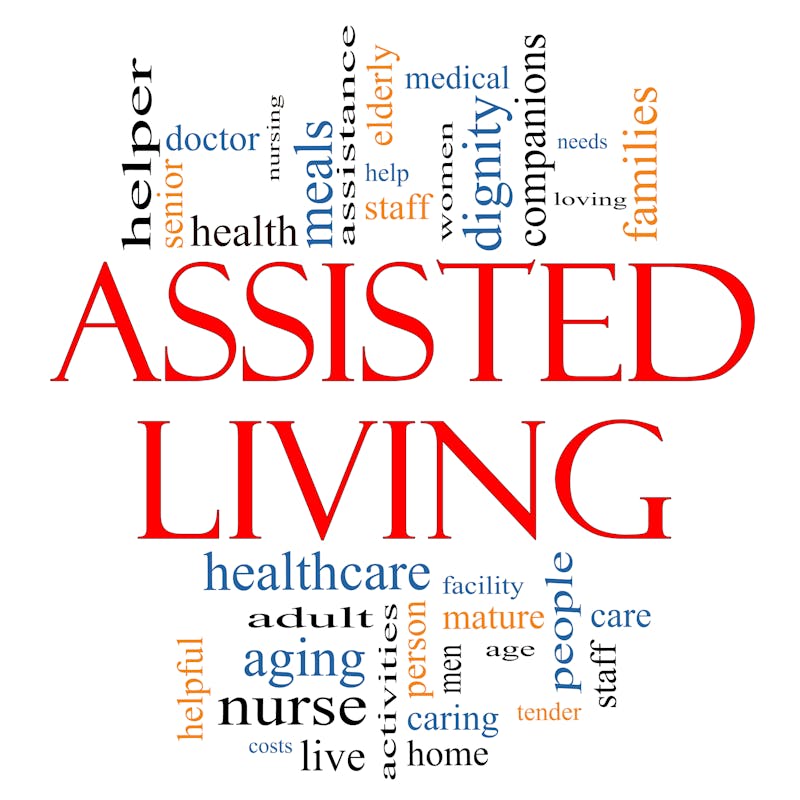Assisted living facilities vary from site to site, as with any of the long term care facility types. In this article, we’ll highlight the types of care, services, accommodations and amenities that are generally offered in assisted living communities.
Ready to dive in? We’ll provide some clarity by answering some questions that are frequently asked about assisted living...
1. What Are Assisted Living Facilities and Who Owns and Regulates Them?
In general terms, assisted living is a long term care solution provided within a residential environment, as opposed to the more medically-centric model of long term care provided in nursing homes. Let’s look into more details of the assisted living model and how these communities are regulated.
What is the definition of assisted living?
Assisted living is a limited long term care service provided in a residential community for seniors or others with disabilities who need help with daily self care but do not require everyday medical care.
Unlike nursing homes, medical “skilled nursing” services are limited or not available on-site at most assisted living facilities.
The U.S. government has not established a national definition of “assisted living”. Further, licensing terms are defined at the state level, which causes inconsistency of its definition from state to state.
Who owns and regulates assisted living?
In 2016, there were approximately 28,900 assisted living facilities housing an estimated 811,500 residents in the U.S.
The majority (82%) of assisted living facilities are owned by private, for-profit public or limited liability companies. Non-profit organizations and governments make up the remainder of the owners.
In the U.S., each individual state regulates and licenses assisted living facilities, so the requirements to own an assisted living facility vary from state to state.
2. What Levels of Care Are Provided in Assisted Living?
The level of care services offered to residents in assisted living communities often bridges the gap between home care and skilled nursing care.
Non-medical, personal care assistance is offered at assisted living facilities to help residents with their “activities of daily living”, like showering or bathing or “instrumental activities of daily living”, like house cleaning and laundry. (Commonly referred to as ADLs and IADLs
Key Point #2: Residents of assisted living typically need help with two or more activities of daily living, like bathing and dressing.
3. What is Memory Care in Assisted Living?
For more information on memory care, check out AgeChoice’s articles and videos specifically on this important topic.
Key point # 3: Assisted Living Home can also include memory care units which are secured and specialized areas for people with Alzheimer’s, dementia, or other memory related impairment.
4. What Other Services are Included in Assisted Living?
A highlighted benefit of assisted living communities is that all daily meals are prepared for and provided to residents. Residents can enjoy nutritious meals prepared by professional chefs, and are relieved of the burden of planning meals, grocery shopping or cooking.
Most communities serve meals in common area dining rooms or cafeterias, but also provide optional room delivery.
Safety and security is another valuable benefit to residents of assisted living communities. Residents can live independently, yet have 24-hour support and care should they need it.
Assistance is available for housekeeping tasks like vacuuming, dusting, cleaning bathrooms, changing bed linens and laundry.
Pharmacies, hair salons and physical therapy are common services that are provided on-site.
Some states require assisted living facilities to manage and administer medications, but facilities in other states offer an optional medication management service to its residents.
Key Point #4: Assisted living homes prepare daily meals and assistance is available for housekeeping, laundry and transportation which are activities known as instrumental activities of daily living.
5. What Are Some Other Benefits of Assisted Living?
Key Point #5: Assisted living communities provide a home-like setting that offers social opportunities and activities for their residents while providing the security to allow them to remain as independent as possible.
6. What is an Assisted Living Home Like and What Other Amenities Are Offered?
Assisted living communities consist of a number of home-like rooms or apartments for their residents. Rooms can vary from studio apartments to one- or two-bedroom apartments and occupancy can be either private or shared.
Some apartments include a small kitchen with a refrigerator, and most residences are equipped with an emergency call system. Special memory care apartments feature greater security and may not have kitchens due to safety concerns.
In 2010, the CDC surveyed residential care facilities and reported the following statistics on assisted living residential rooms:
- 40% of assisted living homes are studios or 1-bedroom apartments
- 75% of residents occupy private rooms or apartments
Assisted living common areas often include libraries, game rooms, television or movie theaters, fitness rooms, pools, and outdoor gardens.
Key Point #6: Residences within assisted living facilities are primarily privately-occupied apartments with private kitchens, bathrooms, and bedrooms.
7. Can Couples Remain Together in Assisted Living?
Many assisted living communities allow couples to live together in the same apartment, provided that both residents can be cared for by the facility.
According to the 2010 CDC study of assisted living facilities, of those residents sharing a room or apartment, 23% share with a spouse or other relative.
This accommodation allows couples who have different care needs to continue to enjoy the companionship of their spouse. Typically, costs are based on the needs of the spouse who needs a higher level of service.
8. Are Assisted Living Facilities “Pet Friendly”?
Benefits of pet ownership, like companionship and better overall health, can ease the transition for many seniors into assisted living. Pets that need daily walks can keep their owners active, and are almost always great conversations starters, which certainly helps with socialization.
The companionship of a pet can be an important factor in the selection of an assisted living community for a senior. Where permitted, house cats and smaller dog breeds make great companions to community residents.
Unfortunately for pet owners, the reality is that some facilities do not allow pets. To overcome the absence of pets, facilities may have “community pets” for residents to enjoy. Furthermore, regularly scheduled pet or animal therapy programs may be beneficial to residents.
Key Point #8: Pets are permitted in many assisted living communities, but there are typically restrictions by their size.
9. What is the Cost of Assisted Living?
Costs for assisted living long term care depends on many factors, but the local cost of living has the largest impact on facility fees. Types and level of care services provided will also impact the total monthly cost.
What is the Average Cost of Assisted Living?
The national projected average cost for assisted living in 2019was $4000 per month. The state of Utah had the lowest projected average annual cost at $40,200, while the District of Columbia tops out averaging over $111,000 per year.
Costs for additional services can add up quickly, so it’s advisable to be aware of the specific services included in base pricing.
In planning for future needs, remember that costs continue to rise. To help estimate current costs and project future costs for senior care in your area, refer to Genworth’s Cost of Care Survey Calculator. .
What is the Cost for Memory Care in Assisted Living?
Due to the specialized skills and security for cognitively impaired patients, monthly costs are higher for memory care in assisted living, averaging $800 to $1200 over the basic assisted living services cost.
Is Government Assistance Available for Paying For Assisted Living?
Medicaid is funded by both the federal government and the individual states, so benefits vary by state. The majority of states (44, plus the District of Columbia) provide some level of financial assistance for assisted living costs through Medicaid.
U.S. veterans and their spouses may be eligible for taxable-free Aid and Attendance benefits that provide financial assistance to cover care costs.
For memory care patients with private insurance, Medicare Advantage supplemental insurance can help to pay for some costs, thanks to the recent updates in Medicare laws.
Finally, let’s discover how a person is determined to be eligible to live in an assisted living community.
Key Point #9: The average cost of assisted living is about $4000 per month and can increase by about $1,000 for Memory Care with costs varying based on location and exact care needs.
10. How Do You Qualify for Placement into Assisted Living?
Qualifications for admission to assisted living typically involve:
- An assessment of the patient’s physical needs along with
- proof of financial resources that’ll pay for assisted living residential care.
Admission Requirement: Patient Assessment
Due to the level of care provided at assisted living, an evaluation of the patient’s care needs is necessary to determine if the services provided by assisted living facilities align with the patient’s current and future care needs.
Prospective resident’s care needs are determined by a senior needs assessment, typically conducted by a staff nurse or a facility admissions employee. (See the Caregiver’s Library sample of a needs assessment worksheet, which illustrates some of the information gathered during a patient evaluation.)
Individuals may be eligible for admission to an assisted living facility if their care requires assistance with at least two ADLs (activities of daily living), and typically does not require daily skilled nursing care.
Results of the patient’s needs assessment help to determine services that will be needed during residency, provide an estimate of service expenses, and develop an initial care plan.
Financial Assessment
Assisted living facility costs are less expensive than nursing home costs, but (with very few exceptions) are not covered by Medicare or Medicaid. This chart of annual assisted living costs by US state state can help estimate financial requirements.
Proof of long term care Insurance, VA Aid and Assistance or other funding resources to cover two to three years of facility costs may be required.
Key Point #10: A qualified resident medical assessment and proof of financial resources are typically required for admission into an assisted living community
Assisted Living: Key Points for Seniors to Know
Assisted living communities consistently provide a safe and secure residential and socially stimulating environment for seniors who need help with daily tasks like bathing or dressing. However, we’ve learned that the services and amenities that define assisted living residential long term care can vary significantly from location to location.
Here are the key points for seniors to know about Assisted Living:
Top 10 Summary
1. Assisted living is a limited long-term care service in a residential community for seniors, which is regulated and licensed by individual states.
2. Residents of assisted living typically need help with two or more activities of daily living, like bathing and dressing.
3. Assisted Living Home can also include memory care units which are secured and specialized areas for people with Alzheimer’s, dementia, or other memory related impairment.
4. Assisted living homes prepare daily meals and assistance is available for housekeeping, laundry and transportation which are activities known as instrumental activities of daily living.
5. Assisted living communities provide a home-like setting that offers social opportunities and activities for their residents while providing the security to allow them to remain as independent as possible.
6. Residences within assisted living facilities are primarily privately-occupied apartments with private kitchens, bathrooms, and bedrooms.
7. Couples can live together in the same assisted living apartment, provided that neither require care that the facility cannot provide.
8. Pets are permitted in many assisted living communities, but there are typically restrictions by their size.
9. The average cost of assisted living is about $4000 per month and can increase by about $1,000 for Memory Care with costs varying based on location and exact care needs.
10. A qualified resident medical assessment and proof of financial resources are typically required for admission into an assisted living community.




